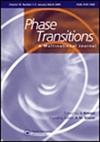Monte Carlo study of the phase transitions in the classical XY ferromagnets with random anisotropy
IF 1.4
4区 材料科学
Q3 CRYSTALLOGRAPHY
引用次数: 5
Abstract
ABSTRACT The three-dimensional anisotropic classical XY ferromagnet has been investigated by extensive Monte Carlo simulation using the Metropolis single spin flip algorithm. The magnetisation (M) and the susceptibility (χ) are measured and studied as functions of the temperature of the system. For constant anisotropy, the ferro-para phase transition has been found to take place at a higher temperature than that observed in the isotropic case. The system gets ordered at higher temperatures for higher values of the strength of anisotropy. The opposite scenario is observed in the case of random anisotropy. For all three different kinds of statistical distributions (uniform, Gaussian, and bimodal) of random anisotropy, the system gets ordered at lower temperatures for higher values of the width of the distribution of anisotropy. We have provided the phase boundaries in the case of random anisotropy. The critical exponents for the scaling laws and are estimated through the finite size analysis.具有随机各向异性的经典XY铁磁体相变的蒙特卡罗研究
利用Metropolis单自旋翻转算法对三维各向异性经典XY铁磁体进行了广泛的蒙特卡罗模拟研究。测量并研究了磁化率(M)和磁化率(χ)作为系统温度的函数。在各向异性恒定的情况下,发现铁-准相转变发生在比各向同性情况下更高的温度下。由于各向异性强度值较高,系统在较高的温度下变得有序。在随机各向异性的情况下,观察到相反的情况。对于随机各向异性的所有三种不同类型的统计分布(均匀分布、高斯分布和双峰分布),系统在较低温度下得到有序,各向异性分布的宽度值较高。我们给出了随机各向异性情况下的相边界。通过有限尺寸分析估计了标度律和标度律的临界指数。
本文章由计算机程序翻译,如有差异,请以英文原文为准。
求助全文
约1分钟内获得全文
求助全文
来源期刊

Phase Transitions
物理-晶体学
CiteScore
3.00
自引率
6.20%
发文量
61
审稿时长
1.4 months
期刊介绍:
Phase Transitions is the only journal devoted exclusively to this important subject. It provides a focus for papers on most aspects of phase transitions in condensed matter. Although emphasis is placed primarily on experimental work, theoretical papers are welcome if they have some bearing on experimental results. The areas of interest include:
-structural phase transitions (ferroelectric, ferroelastic, multiferroic, order-disorder, Jahn-Teller, etc.) under a range of external parameters (temperature, pressure, strain, electric/magnetic fields, etc.)
-geophysical phase transitions
-metal-insulator phase transitions
-superconducting and superfluid transitions
-magnetic phase transitions
-critical phenomena and physical properties at phase transitions
-liquid crystals
-technological applications of phase transitions
-quantum phase transitions
Phase Transitions publishes both research papers and invited articles devoted to special topics. Major review papers are particularly welcome. A further emphasis of the journal is the publication of a selected number of small workshops, which are at the forefront of their field.
 求助内容:
求助内容: 应助结果提醒方式:
应助结果提醒方式:


